Buying guide for best rotating lawn sprinklers
Your lawn is alive and growing. Just like any other living thing, it needs attention and care in order to thrive. One of the best ways you can show your greenery some love is to keep it watered. And one of the best ways to do that, especially if you have a midsize lawn, is with a rotating lawn sprinkler.
Lawn sprinklers offer precise control – better than you can get by walking around with a hose and manually watering your yard — but if used improperly, a sprinkler can do more harm than good. How much water should you use? When is the best time of day to water your lawn? How does a rotating sprinkler work?
Lawn watering 101
Just like people, lawns need water to survive. Since grass is extremely efficient at collecting and using water, keeping your lawn hydrated is a fairly simple task. There are only two things you need to know to be a master lawn waterer: when and how much to water.
When to water
Believe it or not, when you water your lawn is pretty important. The best time is the morning, after the sun has come up but before it gets too hot. Why? The water needs time to soak into the soil so the grass can absorb it. If you try watering in the afternoon, the heat of the sun will evaporate the water before it can be absorbed. Also, water pooling on the grass after the sun has set can create conditions that are ideal for disease to take hold and spread.
How much to water
Your grass doesn't need all that much water. About one inch of water each week is usually sufficient – and that includes rainwater. One inch of water is what it takes for the soil to become moist six to eight inches deep, and that's the sweet spot for grass.
Types of lawn waterers
Before taking a closer look at rotating lawn sprinklers, we'll take a quick glance at other options, just to be certain that the rotating sprinkler is the one best suited to your needs.
Soaker hose: This hose is made of a porous substance like fine-crumb rubber that lets water seep slowly through to soak a long, narrow area. This option is better for garden rows than yards.
Stationary sprinkler: This sprinkler connects to your hose and sprays water in a singular pattern over a relatively small area. Although it’s easily moved, this type of sprinkler is best for small areas.
Oscillating sprinkler: This is a short tube that lies on the ground spraying water out through several holes as the tube rolls back and forth, creating a large, oscillating arc of water. This sprinkler is best for large, rectangular patches of grass.
Impulse sprinkler: You can recognize this sprinkler by the distinctive “click, click, click” sound it makes as it rotates. This sprinkler spurts out a jet of water and is a good choice for larger areas that are subject to occasional wind. It’s also adjustable, so you can focus on specific areas that need a little more attention.
Traveling sprinkler: Imagine a tractor with a hose. The traveling sprinkler rolls about in a preset pattern to cover large or oddly shaped areas.
In-ground sprinkler system: This complete system is permanently installed in your lawn. It’s typically automated and will cover whatever area it’s designed to cover.
Expert Tip
If you want to water your lawn in the early morning hours, but you aren’t an early riser, purchase a timer that turns your rotating sprinkler on at a specific time on certain days for a designated number of minutes.
STAFF
BestReviews
Rotating lawn sprinklers
Most rotating sprinklers have a base that rests on the grass, so the sprinkler can easily be picked up and moved. Other models have wheels, so the sprinkler can be dragged along when you pull the hose. Some models have a stake, so the sprinkler can be precisely positioned but later moved if desired. It usually has three arms, each containing one or more openings or adjustable nozzles for the water to spray out.
How a rotating lawn sprinkler works
Remember Newton's third law of motion? It states, "For every action, there is an equal and opposite reaction." That's what makes a rotating sprinkler work. There’s no need for a motor or electricity. The water jetting forward out of the openings pushes the arms backward, making the sprinkler spin.
If your model features adjustable nozzles, position them at the angle you desire – the closer to 90° you get (the water spraying straight up), the smaller the coverage area will be.
Reducing the water pressure slows down the rotation and decreases the distance that the water travels.
Increasing the water pressure speeds up the rotation and increases the distance that the water travels.
Since you are in control of the size of the coverage area, a rotating sprinkler is a versatile tool that works in many different situations. It works quickly – most models deliver an inch of water in about an hour – and it provides even, gentle coverage, making it good for small to medium lawns or gardens. Because of its circular pattern, a rotating sprinkler is not the best choice if you want to water a long, narrow patch of ground.
"Although your yard needs about an inch of water each week, it doesn't have to be done on just one day. If you like the idea of running your rotating sprinkler for shorter periods of time, divide the watering into two or three times a week."
STAFF
BestReviews
Rotating lawn sprinkler factors to consider
Distance and coverage
Sprinklers vary greatly in coverage area. If you have a large lawn, check to make sure your sprinkler can handle the job. It might be acceptable to move the sprinkler to two or three different places, but if you need to move the unit much more than that, consider stepping up to a model with greater coverage.
Plastic vs. metal
Plastic has a shorter lifespan than metal, and it might warp or be damaged by direct sunlight. Most rotating sprinklers tend to be made primarily of plastic, which makes them more affordable. If you prefer metal, you’ll usually pay a little more, but the sprinkler should last longer.
Adjustable nozzles
Adjustable nozzles enable you to direct and control where the water goes. This can make a rotary sprinkler the right choice in a number of different lawn-watering situations.
Quick connectors
A quick-connect feature makes it easier to hook your sprinkler to your hose. If the sprinkler you’re considering doesn't have this option available, you can purchase it separately, but it will cost as much as – if not more than – the sprinkler itself.
Did you know?
The type of soil you have will affect how long you run your rotating sprinkler. Sandy soil drains rapidly, so your yard will need to be watered more frequently. Clay holds water, making it possible to water your yard less frequently.
STAFF
BestReviews
Rotating lawn sprinkler prices
The overall price range for rotating sprinklers isn’t large, between $10 and $30 and up.
Inexpensive: Spend up to $10 and you’ll get a very basic rotating sprinkler. Connect it and turn it on. You probably won't have many options.
Mid-range: Your best values are in the $10 to $20 range. The rotating sprinklers in this price range have adjustable nozzles and are constructed fairly well. Spend a little more, $20 to $30, and you'll find heavier-duty sprinklers that have all the flexibility you could want.
Expensive: For more than $30, you'll find kits that include quick connectors and possibly a tripod stand that helps keep the sprinkler from moving or tipping over.
FAQ
Q. My rotating sprinkler is making puddles. What do I do?
A. For some reason (dryness or soil composition), the ground isn’t absorbing the water the way it should. The solution is to water more frequently but for a shorter time. If puddles form after 20 minutes, try watering for half that long.
Q. I think I killed my grass because I forgot to water it and it turned brown. What do I do?
A. Your lawn is more resilient than you might think. Remember, it can survive both fall and winter! If you’ve been taking care of your grass and it turns brown, it has probably just gone dormant. Once you turn your rotating sprinkler back on and let the grass absorb some water, it will turn green again.
Q. How do I know when I've watered my lawn long enough?
A. If you're unsure of how long it takes for an inch of water to come out of your rotating sprinkler, do the container test. Place a number of small containers around your yard, turn on the rotating sprinkler, and start timing. Once the containers have an inch of water in them, note the time, and shut off the sprinkler. However long it took, that's how long you should leave the water running. Alternatively, you can perform this test with a rain gauge.



























